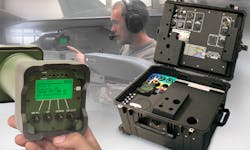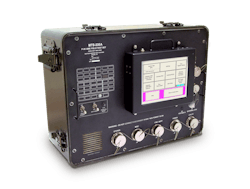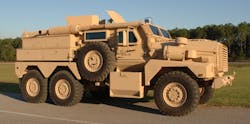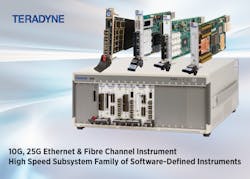Download this article in .PDF format.
In order for a military or aerospace system to operate in an optimal fashion when on the battlefield, it is critical to properly test and evaluate the various solutions.
Serving Military Systems
When we talked to Stephen T. Sargeant, CEO at Marvin Test Solutions, about best practices in the test and evaluation of intelligent military and aerospace subsystems and munitions, Sargeant brought up how Implementing active emulation can bridge the functional test capability gap that current O-level handheld test sets have when used to test current Smart/legacy systems. Next-generation handheld Smart weapon technology is critical to consolidation and modernization of legacy test sets (requiring obsolete handheld and large, multi-box test sets).
Addressing the armament test gap that exists across legacy 4th- and 5th-generation aircraft equipped with Smart weapon technology (MIL-STD-1760), MTS’ MTS-3060A SmartCan Universal O-Level Armament Test Set enables support for any platform and any Smart or legacy armament system. The SmartCan has replaced legacy passive-only test sets with an advanced active-test methodology in more than 12 countries today.
In order to reduce operating costs, and improve response times and shorten repair cycles, operators often set up a local electronic repair workshop within their own field maintenance centers to test and find faults with the electronic assemblies and PCBs to avoid sending subsystems far out of the field of operations. This not only saves time and money, but also reduces the unavailability of vital transport stock and equipment. Reduced in-service breakdowns and improved fleet capability ensure that transit and field systems run more smoothly.
In former times, numerous separate instruments, manually wired connections and paper test procedures operated by skilled technicians were adequate. These repairs were covered by trained-technician repair shops in dedicated off-site repair centers. Nowadays, with the emphasis on efficiency and reduced costs, universal automated test systems have replaced individual test instruments, but these can be extremely expensive, and some of them come with a steep learning curve.
Automatic test equipment (ATE) products perform automated or computerized test procedures on a device under test, including functional testing of ICs, analog and digital components, complete boards, etc., and they vary in complexity in order to provide repair capabilities with different levels of test capabilities for differing board complexities. Computer-based automated test procedures can run reliably and consistently with test results being captured automatically, with high accuracy, high test speeds and extreme flexibility.
Typical ATEs include: In-Circuit Testers, performing device level tests on components mounted circuit boards; Functional Testers, used to test full functionality of boards and modules via edge connectors; Boundary Scan Testers for products that are JTAG-compliant such as BGA, FPGA, CPLDs, or even complete boards with a JTAG connector. ATEs have given power and independence to military forces when it comes to electronic repair. Becoming equipped with
automatic testing means that repair facilities don’t have to rely on outside contractors; they can reduce repair time and cost, and even refurbish and repair outdated and old electronics closer to their use.
Factors to consider when selecting a suitable product include cost, ease-of-use, training availability and expandability. Care must be taken to consider if the system can cope with obsolete and state-of-the-art electronics. Whether you are military planner, an engineer, or a servicing officer, there are test products to be found that will provide solutions to meet individual requirements to keep transportation electronics working and reduce system costs. While today’s ATE systems are modular and configurable to support multiple different test methods, they need to be easy to use and to become familiar with.
When asked about mil/aero test, Alan Lowne, CEO of Saelig, described how the long life spans of vehicle-based electronics, combined with the inevitable obsolescence issues, are an ongoing problem in the military. Automated test technologies are easing the pain. Keeping obsolete and disparate systems running reliably is a constant task for military planners.
Automated test technologies are easing the pain. Keeping obsolete and disparate systems running reliably is a constant task for military planners. Ensuring the reliable and safe operation of a wide variety of military systems often means that electronic assemblies and boards that malfunction or need routine testing are returned to their respective OEMs for evaluation. This creates expensive and inconvenient downtime for equipment out of service.
In order to reduce operating costs, and improve response times and shorten repair cycles, operators often set up a local electronic repair workshop within their own field maintenance centers to test and find faults with the electronic assemblies and PCBs to avoid sending subsystems far out of the field of operations. This not only saves time and money, but also reduces the unavailability of vital transport stock and equipment. Reduced in-service breakdowns and improved fleet capability ensure that transit and field systems run more smoothly.
In former times, numerous separate instruments, manually wired connections and paper test procedures operated by skilled technicians were adequate. These repairs were covered by trained-technician repair shops in dedicated off-site repair centers. Nowadays, with the emphasis on efficiency and reduced costs, universal automated test systems have replaced individual test instruments, but these can be extremely expensive, and some of them come with a steep learning curve.
Automatic test equipment (ATE) products perform automated or computerized test procedures on a device under test, including functional testing of ICs, analog and digital components, complete boards, etc., and they vary in complexity in order to provide repair capabilities with different levels of test capabilities for differing board complexities. Computer-based automated test procedures can run reliably and consistently with test results being captured automatically, with high accuracy, high test speeds and extreme flexibility.
Typical ATEs include: In-Circuit Testers, performing device level tests on components mounted circuit boards; Functional Testers, used to test full functionality of boards and modules via edge connectors; Boundary Scan Testers for products that are JTAG-compliant such as BGA, FPGA, CPLDs, or even complete boards with a JTAG connector. ATEs have given power and independence to military forces when it comes to electronic repair. Becoming equipped with automatic testing means that repair facilities don’t have to rely on outside contractors; they can reduce repair time and cost, and even refurbish and repair outdated and old electronics closer to their use.
Factors to consider when selecting a suitable product include cost, ease-of-use, training availability and expandability. Care must be taken to consider if the system can cope with obsolete and state-of-the-art electronics. Whether you are military planner, an engineer, or a servicing officer, there are test products to be found that will provide solutions to meet individual requirements to keep transportation electronics working and reduce system costs. While today’s ATE systems are modular and configurable to support multiple different test methods, they need to be easy to use and to become familiar with.
Emulation as force multiplier
When we reached out to Dan Walsh, Director, Defense & Aerospace Marketing at Teradyne, he said that the latest, most advanced weapons systems are more complex, and utilize more interconnected subsystems and sensors, than ever before. As a result, the volume of data moving within the system is always increasing. This requires the adoption of new, reliable, high-speed network technologies at a faster and faster rate. Focusing on software-defined, reconfigurable, high-speed instruments and systems is the key enabler to support these new weapons systems.
To be able to provide the most cost-effective test solutions, in the ever-shortening design cycle and faster deployment, it is essential to use test platforms and instruments that can be reconfigured and repurposed as weapon systems evolve. It is essential to use highly adaptive test instruments, which support a wide range of interface speeds and protocols. Utilizing instruments that support test applications throughout the weapon system product lifecycle—from design and evaluation, to production, deployment, and sustainment—provides test system designers the flexibility to support both the needs of today and the requirements of tomorrow.
Walsh also said there are two key issues Teradyne sees: the proliferation of more I/O technologies and the need for faster deployment of new weapon platforms. Gone are the days of an aircraft or weapons system based primarily on a single core data bus technology such as MIL-STD-1553. The systems of today are employing a more diverse set of avionics communications technologies including high speed Ethernet, Fibre Channel, Firewire, InfiniBand, sFPDP, and more.
This complicates the design of robust test systems used to support these new military platforms and drives the need for test instruments that support multiple data bus types to promote, reuse, and extend the test system life cycle. Innovative, open-architecture test platforms and instrumentation provide flexible, scalable, software-configurable solutions which are essential to the design of cost-effective ATE and simulation systems in this environment.
Although the communication technologies have gotten more complex, the military programs today require shorter development and deployment cycles. This drives the need for higher-performance and faster-to-deploy test solutions. We are seeing more and more customers needing fully-integrated and complete test solutions including hardware, software, test programs and other engineering services to solve very complex test requirements and meet their schedule.
Walsh finished by pointing out the importance of addressing the challenges of supporting a more diverse and higher-speed set of avionics network technologies by designing instruments which are more reconfigurable, and therefore capable of supporting a range of network interface protocols over a range of speeds. At the same time, Teradyne is making more intelligent instruments capable of offloading more tasks from the host system to accommodate the increasing volumes of data that must be handled during test and maintenance activities.





